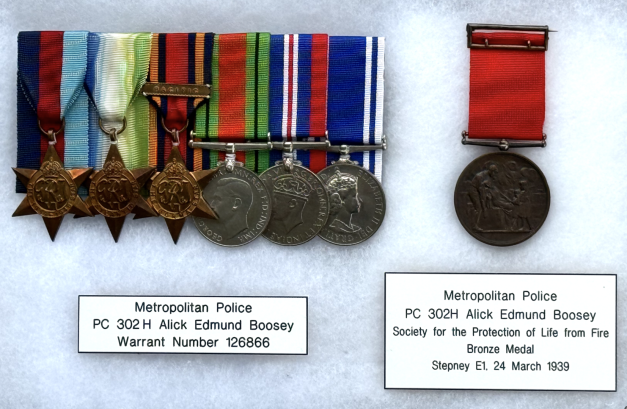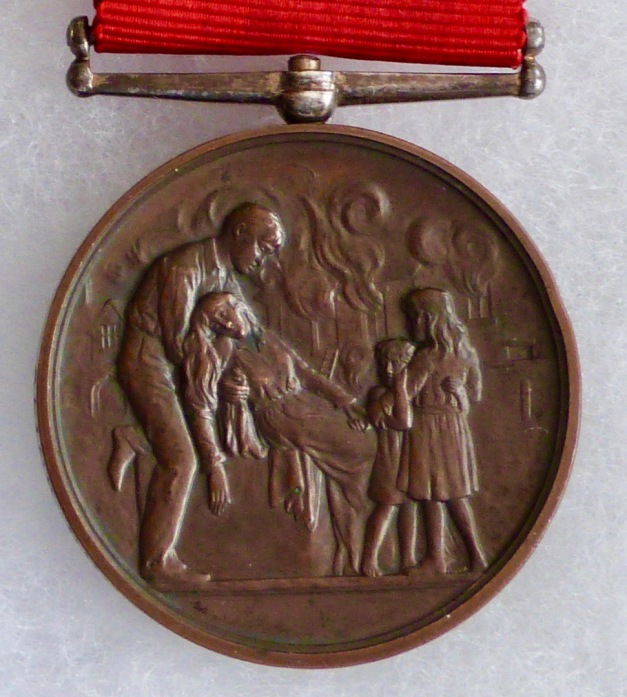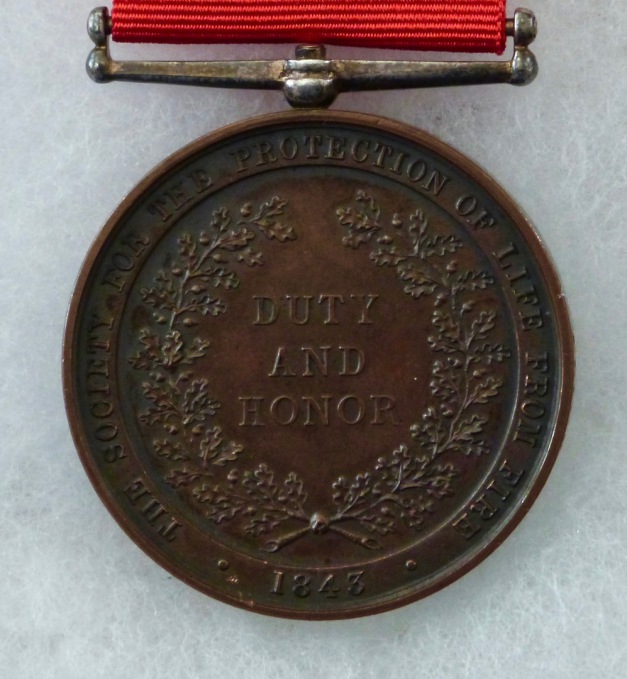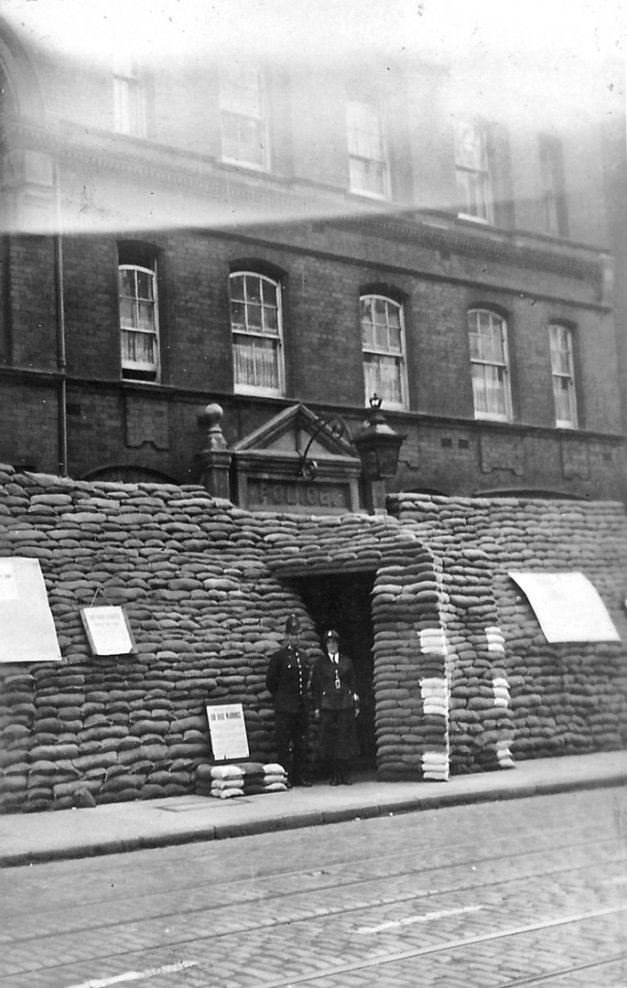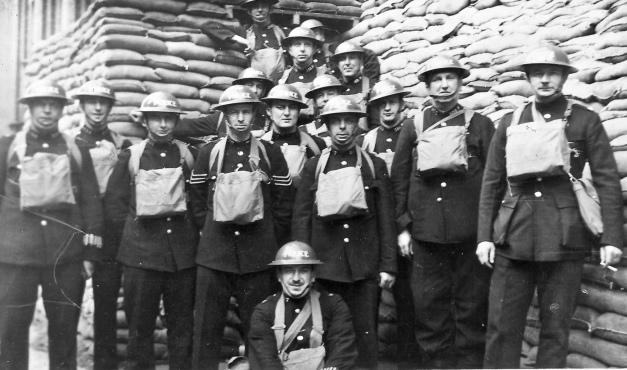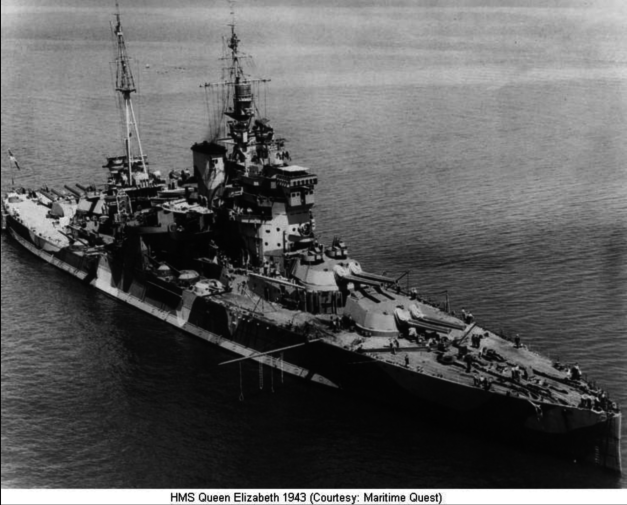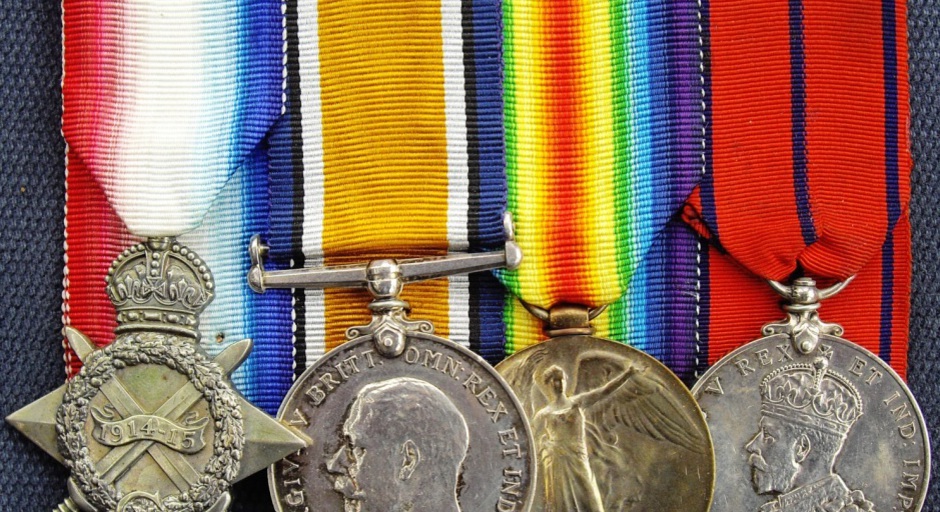
Metropolitan Police - PC Alick Edmund Boosey
The Society for the Protection of Life from Fire:
SOCIETY FOR THE PROTECTION OF LIFE FROM FIRE (SPLF) MEDALS:
My main interest is Scottish Police medals, although I am also interested in Metropolitan Police medals for Gallantry. Whilst not having the cachet of ‘Medals for Gallantry’, I hoped this group would be an interesting research project with the main sources being local and national newspapers, SPLF archives and MP records. I quickly found this to be the case.
What follows is a brief description of the awarding body, the SPLF, then a chronological account of the circumstances that led to PC Boosey’s bravery being recognised, a description of the family involved in the tragedy resulting in the deaths of two children and including the aftermath of the fire, inquests and burial. The article concludes with details of PC Boosey's career in the Metropolitan Police.
SOCIETY FOR THE PROTECTION OF LIFE FROM FIRE:
The SPLF was formed in 1836 in order to preserve life through the provision of fire-escapes and attendants at around seventy locations in London in an age before local authority fire brigades. [i] An excellent description of the activities of the RSPLF can be found in Crutchley’s London in 1865: A Handbook for Strangers.[ii]
“The Society maintains, in different parts of the Metropolis, 73 fire-escape stations, usually at distances of half a mile from each other. At each station there is a fire-escape, attended throughout the night by a conductor well instructed in its use, and provided with all necessary implements. From 1843 to March 31, 1861, the Society’s fire-escapes have attended no less than 5211 fires and rescued 670 lives. The fire-escape in use is Abraham Wivell’s; its height varies from 43’ to 45’ and by means of a supplemental ladder even 60’ can, if necessary, be obtained. Each machine weighs 8.5 cwt and costs 60/-.”[iii] [iv]
An interesting image of the map created by Wivell showing the locations of the fire-escapes in London and a model showing the two types can be seen at the Science Museum Group website. [v]
The SPLF received the Royal Patronage of Queen Victoria in 1837 and was styled ‘The Royal Society for the Protection of Life from Fire’ (RSPLF) until her death in 1901.
SPLF AWARDS:
Historically, the society has been supported by insurance companies and that support continues to this day. The SPLF Trustees are still drawn from the insurance industry and scrutinise nominations for awards from Chief Officers of Police and the Fire Service.[vi]
The SPLF now only awards certificates and medals but in the past, bronze medals, silver medals, silver watches and certificates were awarded.
The bronze medal featured in this article was awarded to PC 302 H Alick Edmund Boosey of the Metropolitan Police for his efforts in assisting in the rescue of a family whose house in Stepney was on fire.
[ii] Crutchley’s London In 1865: A Handbook for Strangers (http://www.victorianlondon.org/charities/preservationoflifefromfire.htm/)
[iii] https://collection.sciencemuseum.org.uk/objects/co45172/two-models-of-abraham-wivells-fire-escapes-model-fire-escapes
[iv] https://www.victorianlondon.org/charities/preservationoflifefromfire.htm
[v] https://collection.sciencemuseum.org.uk/objects/co45172/two-models-of-abraham-wivells-fire-escapes-model-fire-escapes
FIRE IN 91 BIGLAND STREET, STEPNEY, 24 MARCH 1939:
Author's Note: I have used the spelling of names from the newspapers of the time and corrected them conventionally.
On Friday 24 March 1939, just after midnight, Florence Rose Hazard of 91 Bigland Street, Stepney in London was asleep in the first-floor front bedroom when she was awoken by her son Joseph. The flat was above a shop in which her partner Jack ran a general dealer’s business. She could see flames rising up the stairs and the smoke was choking her. Her son Joseph opened the bedroom window as far is it would go, climbed over and dropped to the street and called the patrolling police officer, PC Boosey of H Division at Leman Street. The PC arrived on scene just after midnight and having sent for the Fire Brigade, began dealing with the incident. [i] Three of the neighbours had been alerted by the screams coming from number 91 and assisted PC Boosey to rescue the family.
Joseph Thomas Burford (sic)[ii] of 93 Bigland Street heard screams from the house next door occupied by the Hazard family. Mr Burford (sic) and his son Thomas, left their home to see what was happening. The whole ground floor of No. 91 was alight, and flames were up to the first floor. Burford (sic) could see Mrs Hazard in a kneeling position on a first floor window sill. There was smoke and flames in the room behind her.
PC Boosey assisted by Joseph and Thomas George Burford (sic), rescued Mrs Hazard and her son Leonard by Thomas standing on his father’s shoulders and he and PC Boosey catching them as they jumped. The father and one of his sons also managed to escape from there.
In the confusion, it was thought that all the family had been rescued however, when the five family members were reunited in the street, it was realised that the youngest child, Ronald Lewis Hazard, was still in the house. Mrs Hazard screamed ‘Save my baby’. It was ascertained that the child was still in a first-floor bedroom. PC Boosey attempted a rescue by entering the front door but was beaten back by the flames and smoke on the stairs, the effects of which, later caused him to be admitted at St George In the East Hospital, Shadwell. [iii]
William Sands, Inspector at Shadwell Fire Station arrived shortly after at 12.13am and was in charge at the scene. It took twenty minutes to get the fire under sufficient control to enter and search for Ronald. They found the child dead in the front room of the first floor within six feet of the window. [iv]
Harry and Florence Hazard and their sons Joseph, Leonard and Harry, were also admitted to the same hospital, all with serious burns. Two firemen were also treated for injuries sustained in the fire. According to one newspaper, ‘more than 150 firemen attended the outbreak and the flames reached a height of 25 feet.’ [v]
It was reported on Saturday 25 March 1939 that a second child had died as a result of the fire in Bigland Street the previous day. Leonard George Hazard, (10), had died of his injuries in St George in the East Hospital where his father, mother and two surviving brothers were stated to be “quite comfortable”. [vi]
METROPOLITAN BOROUGH OF STEPNEY COUNCIL MINUTES, 1939:
His Worship the Mayor, Councillor Joseph Johnson J.P. chaired the meeting of the Metropolitan Borough of Stepney Council on Wednesday 29 March 1939 and the minutes record the following under ‘Urgent Communications’:
“No. 91 Bigland Street – Fire at.
His Worship the Mayor referred to the outbreak of fire which occurred at No. 91, Bigland Street, E.1, the home of Mr. J. Hazard, in the early morning of Friday, the 24th March, 1939, as a result of which two children met their death and the remainder of the family were injured, their house and home being completely gutted out and their business destroyed, thus rendering them homeless and destitute.
His Worship informed the Council that the funeral of the two deceased children would take place on Monday next, the 3rd April 1939 at 3 o’clock in the afternoon, at Christ Church, Watney Street, E. 1, and expressed the hope that as many members of the Council as possible would attend the service to demonstrate their sympathy with the bereaved family.
(Noted)”[vii]
INQUEST INTO DEATHS OF LEONARD AND RONALD HAZARD Day 1:
The inquest into the deaths of Leonard George Hazard and his younger brother, Ronald Lewis Hazard began on Tuesday 28 March 1939 at Stepney Coroner’s Court and presided over by Mr William Bentley Purchase, M.B., D.P.H., Deputy Coroner, Eastern District, London, Westminster and South London districts. [viii]
Evidence was taken from an aunt of the two boys, Mrs Louisa March from Lewisham who, in the absence of the mother, gave evidence of the identity of the children and their address. PC Boosey and several of the neighbours, the Brufords and Joseph Saunders gave evidence as well as. All described the screaming from the house, the chaos and confusion over how many had escaped and their attempts at rescuing all of the stricken family.
Florence Rose Hazard was too ill to attend that day and the Deputy Coroner adjourned proceedings to Friday 31 March 1939.
RESUMED INQUEST INTO DEATHS OF LEONARD AND RONALD HAZARD Day 2:
The City and East London Observer edition of Saturday 8 April carried a full account of the evidence led at the resumed inquest on 31 March.
Mrs Florence Hazard, with her arms still heavily bandaged gave evidence that she and her family occupied the premises at 91 Bigland Street as a second hand furniture business and lived in the flat upstairs. She stated that the flat was lit by gaslight which they did not use. They used candles instead but on the night of the fire, all had been extinguished by her before she went to bed around 10.30 pm. She slept in the front room of the first floor.
A low coal fire was left on in the kitchen and she felt it was quite safe despite there being loose bricks in the grate. About midnight, she was woken by her son Joseph and she saw flames and the smoke choked her. She made for the window above the street and her son climbed over the lower part of the sill and dropped to the street to fetch help.
She was questioned by counsel regarding dangerous structures notices affecting the building but denied ever seeing such a notice.
Percy Brown, a building manager for the landlords, Messrs. Charles Benabo, said they were the agents for the property. He had received no complaints from the rent collector about the fireplace. He also stated the fireplace was in perfect order including the flue and the brickwork. Mr Brown said that the floor beyond the cement was in good order and even the lino there had not been burnt. He was of the opinion that the settee was far too close to the fire. He had measured the distance between the (burnt) framework and the fire and allowing for padding on the settee, it would be eight or nine inches.
William Sands, Inspector at Shadwell Fire Station had stated that if the fire had been due to anything falling from the grate, they would have expected the floor to be damaged.
The Coroner recalled Mr Percy Brown and asked him “What about the window? It was said that the bottom part was immovable?”. (Brown replied) “I could not say that”. “Well assume it was”. “That would have been on the sanitary notice. It’s my job to remedy that”. Have you had any complaints in connection with that?”. “No”.[ix]
There was further evidence concerning the window from Mrs Hazard, John Walker Hallett, a rent collector and William Anstey, a Sanitary Inspector. Hallett and Anstey denied that Mrs Hazard had reported the defective window to them.
THE CORONER’S VERDICTS:
In reviewing the evidence, the Deputy Coroner Mr Bentley Purchase, according to the East London Advertiser, made the following observations:
“Apparently the fire had been caused in a piece of furniture being too near the room fireplace. Any defect in the fireplace did not point to anything.
When the fire was discovered there was a difficulty in getting out of the window. He felt that those who gave the people assistance in getting out, particularly the police officer (PC Boosey), did all they could in the few minutes available. He was impressed by their actions. It was difficult to say whether the window being up or down made any difference to the rescues.
It was clear that it was not the fault of the landlord that the fire had occurred.
A verdict of ‘Accidental Death’ was recorded in both cases.” [x]
Having the Coroner’s verdict, it was now possible for the family to register the deaths and this took place in Stepney on 1 April.
Ronald Lewis Hazard, (5), died on 24 March 1939 at 91 Bigland Street, Stepney. His occupation was shown as ‘Schoolboy. Son of Florence Rose Hazard, a Housekeeper’. [xi]
Leonard George Hazard, (10), died on 25 March 1939 in St George in the East Hospital. His occupation was shown as ‘ Of 91 Bigland Street, Stepney. Son of Joseph Hazard, a Cinema Attendant.’ [xii]
THE FUNERAL 3 APRIL 1939 CHRIST CHURCH, WATNEY STREET, STEPNEY:
The East London Observer of Saturday 8 April 1939 gave a detailed account of the funerals of Leonard and Ronald Hazard.
“Hundreds of housewives and schoolchildren lined the route from 81 Bigland Street, Stepney to Christ Church, Watney Street, when the funeral of Ronald Hazard, aged 5 and his brother Leonard, aged 10, who lost their lives when fire broke out at their home, took place on Monday afternoon. Many people were in tears. Police officers stood by to prevent the roadway being blocked.
The bodies were brought out and placed in separate hearses from the house of Mrs T. G. Bruford. When the cortege started, it was followed by three carriages in which were the relatives. Mr Hazard was present, his arm heavily bandaged and with burns still showing on his face. With him was one of his sons. Mrs Hazard was too ill to attend.
The procession was followed up Bigland Street, down Anthony Street into Mariner’s Street where it halted at the “Refiner’s Arms”, then into Buross Street, along Commercial Road, through Anthony Street again, down into Cable Street and finally into Watney Street and Christ Church.”[xiii]
The short service was conducted by Father Robert Young in the absence through illness of Father Groser. ‘The service was attended by Jews and non-Jews alike’.
The coffins were removed and conveyed to the City of London and Tower Hamlets Cemetery where the interment took place:
“A fund had been started known as the “Bigland Street Fire Fund” by Mr George Jacobs, licensee of the “Refiner’s Arms” who is the chief organiser., together with Mr F. Long to assist the parents. Already, within a week, over £83 has been collected from neighbours and sympathisers in the district. The money was used to cover the cost of the funeral and the wreaths. The remainder will go to the fund which has also been started by the Mayor of Stepney.”[xiv]
Thirty wreaths were with the cortege and they ranged from family and neighbours to the Mayor and Mayoress of Stepney, Leman Street Police Station (where PC Boosey was stationed), Shadwell Fire Station, The Oxford and St George’s Jewish Club and Ronald’s schoolmates.
The same edition also published a letter from Stepney Mayor, Joseph Johnson making an appeal for donations towards his fund for the Hazard family and asking that the organisers of any other fund for the family contact him with a view to bringing them all together. [xv]
[i] The East London Observer, Saturday 1 April 1939.
[ii] Last Name is Bruford on Electoral Roll for Stepney, 1939.
[iii] The East End News, Friday 31 March 1939.
[iv] The East London Observer, Saturday 1 April 1939.
[v] The Daily Herald, Friday 24 March 1939.
[vi] The Birmingham Mail, Saturday 25 March 1939.
[vii] Metropolitan Borough of Stepney Council Minutes, Wednesday 29 March 1939, Page 1196 (L/SMB/A1)
[viii] The City and East London Observer, Saturday 8 April 1939.
[ix] The City and East London Observer, Saturday 8 April 1939.
[x] The East London Advertiser, Saturday 1 April 1939.
[xi] General Register Office, England Document No. DYE 370363.
[xii] General Register Office, England Document No. DYE 37036.
[xiii] The City and East London Observer, Saturday 8 April 1939.
[xiv] The City and East London Observer, Saturday 8 April 1939.
[xv] The City and East London Observer, Saturday 8 April 1939.
SPLF BRONZE MEDAL AWARDED TO PC 302 H ALICK EDMUND BOOSEY 1939:
The SPLF committee meeting to decide on awards took place on Tuesday 18 April 1939. The Bigland Street fire was Case No. 17349 in the minutes.[i] The minutes also recorded that the, ‘Date of Fire and Cause: 24 March 1939. Furnishings ignited by spark from fire’.
Those recommended for an award, presumably by either the Metropolitan Police or London Fire Brigade and the decisions in each case were as follows:
|
Name |
Decision |
|
Alick Boosey |
Bronze Medal |
|
Joseph Saunders |
No award |
|
Joseph T Bruford |
No award |
|
Thomas G Bruford |
No award |
The SPLF minutes are very sparse and there is no detail on which to make a judgement on the decisions.
THE HAZARD FAMILY AFTER MARCH 1939:
I have so far, been unable to find any more information on the outcome of the ‘Bigland Street Fire Fund’ although there is a reference to the initial £83 being used to pay for the funerals and wreaths. I could find no reference to the ‘Mayor of Stepney’s Fund’ in the council minutes for 1939 and 1940. The surviving family were living in Lewisham by the National Registration in September 1939.
THE END OF THIS PART OF THE STORY:
This was a fascinating exercise in medal research in an area with which I was completely unfamiliar. The newspaper reports of the time were quite detailed in their description of anguish and injuries and I have tried to limit the intrusion into the lives of the Hazard family by editing the descriptive language.
PC Boosey was a probationary constable with ten months service at the time of the Bigland Street fire. His actions were exemplary, and he was worthy of his award. It has been rewarding unravelling the story behind this brave man’s recognition and bringing it to a wider audience. It has also, if belatedly, acknowledged the bravery of Joseph Thomas Bruford, Thomas George Bruford and Joseph Saunders, the neighbours. They suffered their own tragedy when between 1939 and 1945, their own houses in Bigland Street were damaged beyond economic repair by enemy bombs.
If I have inadvertently included any factual errors, please feel to contact me and I will happily correct the material.
What follows next is the story of PC Alick Edmund Boosey, his service in the Royal Navy during World War II, and the rest of his life in the Metropolitan Police.
PC 302H Alick Edmund Boosey
Metropolitan Police
The Early Years
Alick Edmund Boosey was born on 28 January 1917 in Lillian Road, Burnham on Crouch, Essex. He was the son of Alick Edmund Boosey, a Sea Wall Repairer, and Ruth Elizabeth Ives. His parents had been married in 1915 in Maldon, Essex. His father had served in the Royal Navy in World War I.
In the Census of England 1921, the family were still living at Burnham on Crouch. By then, Alick had a younger brother, Gordon Frederick Boosey, born in 1921.
Metropolitan Police 1938
Alick Edmund Boosey was appointed to the Metropolitan Police (MP) as PC 302H, Warrant Number 87/126866, in Police Orders dated Monday 9 May 1938. [i]
After initial training, Alick was posted to Leman Street Police Station in the East End of London. It was from there that in the early hours of Friday 24 March 1939 that Alick attended the fire at Bigland Street, Stepney, the events of which are described in detail above.
1939 Register of England & Wales
Listed in the 70 entries for the occupants of the Metropolitan Police Section House at Leman Street, Stepney, in 1939 was PC A. Boosey. [ii]
MP Police Orders Friday 30 June 1939
Police Orders of Friday 30 June 1939 recorded a list of Probationers who had completed the examination on completion of 12 months’ service. Among them was ‘H 302 126866 Boosey’.[iii]
MP Police Orders Monday 15 January 1940
Police Orders of Monday 15 January 1940 carried the following notice under the heading. “Commendations & Rewards’.
“The Commissioner has commended the following officers and has pleasure in notifying the grant of the awards shown: -
...H (96Une/2822). P.C.302-126866 Boosey, a Bronze Medal by the Society for the Protection of Life from Fire, for courage and promptitude displayed in assisting in the rescue of persons from a burning dwelling house”. [iv]
MP Police Orders Friday 10 May 1940
Police Orders of Friday 10 May published a list of Probationers who had been Confirmed as Constable on that date. On the list was ‘H 302 – 126866 Boosey’. [v]
MP Police Orders Friday 23 April 1943
On page 10 of Police Orders of Friday 23 April 1943, a list headed “Navy, Army and Air Force – ‘Off Pay’ under the Police & Firemen (War Service) Act, 1939” was published. Under the list for ‘Royal Navy’ was ‘H 302 – 126866 Boosey’, with pay until 25th April. [vi]
Royal Navy 1943
On 26 April 1943, Alick Edmund Boosey enlisted in the Royal Navy at HMS Collingwood as Ordinary seaman No. JX. 515908. From this initial training base, he was posted a number of times between then and his discharge. They can all be seen in the table below. [vii]
Royal Navy Postings J.X.515908 Alick Edmund Boosey
|
Ship/Shore Establishment |
Rank/Rating Held |
From |
To |
|
HMS Collingwood (Fore Top).
This was a shore base built as a new entry Training Establishment for ‘Hostilities Only’ ratings in the Seaman Branch. It was located between Gosport and Fareham in Hampshire and opened in January 1940. The establishment trained batches of around 1000 trainees joining every 3 weeks for a 10-week course.
On 18 June 1943, there was a German air raid on Portsmouth and surrounding areas. One or more bombs fell on HMS Collingwood and at least one was a direct hit on an accommodation block. The bomb exploded on impact and 29 young sailors died immediately and another 4 died later from their wounds. [i]
|
Ordinary Seaman |
26 Apr 1943 |
04 July 1943 |
|
HMS Victory.
This was the name of a shore-based RN Accounting Base for seaman between postings.
|
Ordinary Seaman |
05 July 1943 |
09 Aug 1943 |
|
HMS Queen Elizabeth.
Originally laid down at HM Dockyard Portsmouth in in 1912, she was launched in 1913, the first RN ship to carry the name.
She served in WW1 and was modernised in 1939 – 1940 at RN Dockyard, Rosyth.
She was in Norfolk, Virginia, USA from September to May 1942 for repairs. She sailed from Norfolk to Boston and then on to Bermuda and Devonport for a refit in August 1943. It is likely that Alick joined the ship here. She took part in working up exercises around Scapa Flow before setting off as part of a flotilla of 6 ships, for the Straits of Gibraltar in December 1943, arriving there on 6 January. The flotilla arrived at Suez on 13 January 1944. By the 19th of January, she was off Aden.
The flotilla then made passage across the Indian Ocean and operated from Trincomalee, Sri Lanka, taking part in several bombardments and other operations against the Japanese Occupied Territories until July 1945, when it made passage to Aden, Alexandria, Gibraltar to Rosyth, arriving on 15 August 1945.
|
Ordinary Seaman |
10 Aug 1943 |
25 Jan 1944 |
|
HMS Queen Elizabeth.
See above. |
Able Seaman |
26 Jan 1944 |
29 May 1944 |
|
Lent: HMS Lanka.
This was a RN shore base at Colombo, Sri Lanka.
|
Able Seaman |
30 May 1944 |
04 June 1944 |
|
HMS Victory.
This was a shore-based RN Accounting Base for seaman between postings.
|
Able Seaman |
05 June 1944 |
05 Oct 1944 |
|
HMS Victory.
This was a shore-based RN Accounting Base for seaman between postings.
|
Acting Leading Seaman |
06 Oct 1944 |
06 Oct 1944 |
|
HMS Victory. This was a shore-based RN Accounting Base for seaman between postings.
|
Temporary Acting Regulating Petty Officer * |
07 Oct 1944 |
16 Oct 1944 |
|
Stamshaw Camp.
This was a RN Training Camp at Portsmouth.
|
Temporary Acting Regulating Petty Officer |
17 Oct 1944 |
No date recorded. |
|
HMS Victory.
This was a shore-based RN Accounting Base for seaman between postings.
|
Temporary Acting Regulating Petty Officer |
No date recorded. |
31 Dec 1944 |
|
Stamshaw Camp.
See above.
|
Temporary Acting Regulating Petty Officer |
01 Jan 1945 |
No date recorded. |
|
HMS Victory.
This was a shore-based RN Accounting Base for seaman between postings.
|
Temporary Acting Regulating Petty Officer |
No date recorded. |
18 Jan 1945 |
|
Travelling. |
Temporary Acting Regulating Petty Officer |
19 Jan 1945 |
19 Jan 1945 |
|
Lent: HMS Bacchante.
This was a shore base in Aberdeen, Scotland, with several buildings around the harbour. Some of the ratings were billeted in the Station Hotel.
|
Temporary Acting Regulating Petty Officer |
20 Jan 1945 |
20 Jan 1945 |
|
HMS Merganser.
This was a shore base, part of Royal Naval Air Station, (RNAS), Rattray in Crimond, Aberdeenshire.
|
Temporary Acting Regulating Petty Officer |
21 Jan 1945 |
22 Nov 1945 |
|
HMS Orlando.
This was a RN shore base at Navy House, Greenock, Scotland. It may have been a Gunnery School or had an Intelligence Function.
|
Temporary Acting Regulating Petty Officer |
23 Nov 1945 |
13 Sep 1946 |
*A Regulating Petty Officer was a Royal Navy Police non-commissioned officer.
Temporary Acting Regulating Petty Officer Alick Edmund Boosey was released to shore in Class A on 13 September 1946 and rejoined the Metropolitan Police on 15 September. [ii]
For his service between 1943 – 1946, Alick was awarded the 1939 – 1945 Star, the Atlantic Star, the Burma Star with ‘Pacific’ clasp, the Defence Medal, and the 1939 – 1945 War Medal. All are shown on his Royal Navy medal entitlement sheet in his record of service. [iii]
MP Police Orders Friday 20 September 1946
Page 430 of MP Police Orders for Friday 20 September 1946 recorded a list of those rejoining the Metropolitan Police on various dates. The now ‘H 194 – 126866 Boosey’ was reappointed on 15 September on a ‘Weekly Rate of Pay of 111/- (£5.55). [i]
Central Record of Service 1943 - 1953
Alick’s central record of service (CROS) shows the following details under the heading, ‘Special Examinations’ taken at the MP driving School. [ii]
|
Course |
Date |
Remarks |
|
Wireless R/T |
24 November 1947 |
|
|
Course No. 136 |
10 June 1948 |
Class III |
|
Course No. 161 |
2 October 1953 |
Class I Driver |
MP Police Orders Friday 10 June 1955
The MP Police Orders of Friday 10 June 1955 recorded under the heading ‘Transfers’ that ‘H 194 to C.O. (B.6) P.C. 126866 Boosey’ to report as directed. 13 June (1955). [iii]
This was Alick’s transfer to the Traffic Department, then under the Commissioner’s Office (C.O.).
MP Police Orders Tuesday 11 October 1960
Pages 708 – 709 of the MP Police Orders of Tuesday 11 October 1960 recorded the names and ranks of those officers whom The Secretary of State had awarded the Police Long Service & Good Conduct Medal. Among those listed was ‘C.O. (B.6). 126866 Boosey’. [iv]
Register of Marriages in the District of Ilford in the County of Essex 1961
On 25 Of March 1961, at The Seven Kings Baptist Church, Ilford, Essex, Alick Edmund Boosey, (44), a Metropolitan Police Officer of 3 Paddenswick Road, London, Married Joan Ivy Burney, (38), an Executive Officer (Air Ministry), of 8 Meadway, Seven Kings, Ilford, Essex. The service was conducted by F. W. J. Butler in the presence of J. A, Burrey and R.E. Boosey. [v]
MP Police Orders Friday 6 December 1968
Under the heading ‘Retirements on account of Ill-health’, the MP Police Orders of Friday 6 December 1968 recorded that ‘C.O. (B.8) PC 272- 126866 Boosey’ had been awarded a ‘Supplemental Pension’. [vi] He was serving at TDM (B.8) at that time.[vii]
Retirement from the Metropolitan Police
Having along with his wife Joan, signed the Form 575, Police Constable Warrant No. 126866, Alick Edmund Boosey of Flat 2, 4 Primrose Gardens, South Ruislip, retired from the Metropolitan Police at midnight on the 16th of December 1968. [viii]
Life after the Metropolitan Police
It is not known what Alick did after retiring from the Metropolitan Police, but his father and sister were by then living in East Sussex. Sometime between 1968 and 1979, Alick and Joan also moved to East Sussex.
The End of the Story
It was there that Alick Edmund Boosey, (61), died on 2 January 1979 in St Mary’s Hospital, Eastbourne, just short of his 62nd birthday. He had been living at 18 Chestnut Drive, Polegate, East Sussex. Joan Ivy Boosey, his widow, registered his death. [i]
Joan Ivy Boosey, (75), a retired Executive Officer (Air Ministry), of 1 The Mill Race, Wannock, Polegate, East Sussex, died in Eastbourne on 7 March 1998. Her death was registered by her sister, Jean Betty Tuck of Ilford, Essex. [ii]
[i] General Register Office, Application No.10179901-1 (QDAB 402151).
[ii] General Register Office, Application No.10179901-3 (QBDAB 404147).
[i] Ibid, Page 430.
[ii] MP Central Records of Service, Warrant No. 126866 Boosey, A. E.
[iii] TNA, MEPO 7/117, Page 464.
[iv] TNA, MEPO 7/122, Page 709.
[v] General Register Office, Application No. 10179901/2 (MXH 654400).
[vi] TNA, MEPO 7/130, Page 1212.
[vii] TNA, MEPO 7/130, Page 1212.
[viii] TNA, MEPO 7/21/111.
